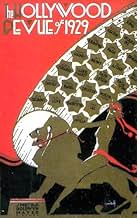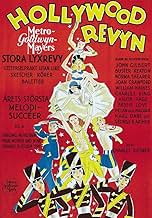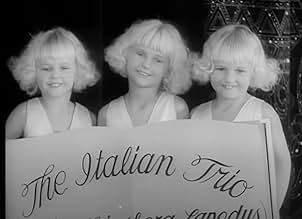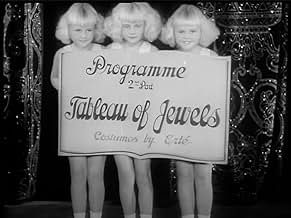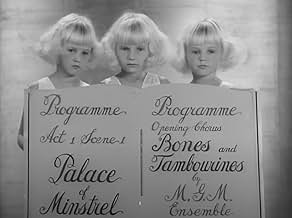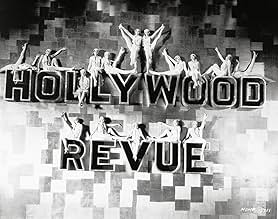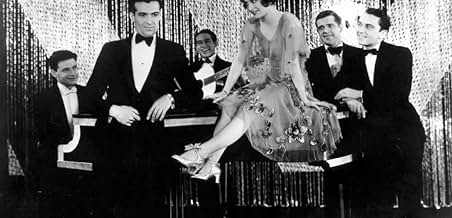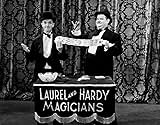AVALIAÇÃO DA IMDb
5,7/10
2,5 mil
SUA AVALIAÇÃO
Adicionar um enredo no seu idiomaAn all-star revue featuring MGM contract players.An all-star revue featuring MGM contract players.An all-star revue featuring MGM contract players.
- Direção
- Roteiristas
- Artistas
- Indicado a 1 Oscar
- 1 vitória e 1 indicação no total
Cliff Edwards
- Ukelele Ike
- (as Ukulele Ike)
Nils Asther
- Nils Asther
- (cenas deletadas)
Brox Sisters
- The Brox Sisters
- (as Brox Sisters - Singing Trio)
- Direção
- Roteiristas
- Elenco e equipe completos
- Produção, bilheteria e muito mais no IMDbPro
Avaliações em destaque
I watched the tape I had made on 4/18/02 again today and read over some of the comments that have been made on this old curio and I felt the need to add a few more observations of my own.
- Firstly, I enjoy watching old films. I see them not as competitors with current entertainment but as portholes into the past. I see the past as a series of presents and the present as living history that we are privileged to witness. Old films allow us to `look' at past era, such as 1929, up close. Each era contains its classics, such as this same year's `All Quiet on the Western Front', that are so good that they are timeless. But most of what was created was material such as Hollywood Review of 1929, designed to provide entertainment for the masses, to the tastes of the age. These people were not making this film to entertain us but rather to entertain the audiences of 1929. They must have done a good job, as this was a big hit. There is plenty of material being produced today that will look just as silly to future generations. Some of it looks pretty silly right now.
- Keep in mind that while the cinema was three decades old at this time, sound recording was an infant. Not only do we hear the `clump clump clump of the dancer's feet but the limitations imposed on the camera by the new technology had stripped a generation of innovations from the medium and what we have is a very flat rendering of a stage review. In time, Hollywood would rediscover how to make films- essentially they filmed much of them in silence and added what sounds they wished us to hear afterwards. We could hear the tap of Fred Astaire's shoes but the clump of the dancer's feet would be muted. The songs would be dubbed in under controlled conditions in a studio. The same presentation would have been done a lot better just a few years later. But this is the best that could be done in 1929.
- In the wake of the development of sound, Hollywood rushed out movies that exploited the new technology as fast as they could, (this one was put together in 28 days), just as a lot of films today use computer generated monsters, armies, cliffs, etc., just to show off what they can do. We have to remember what a miracle watching movies stars talk must have seemed like at the time. Whenever a technical process becomes a drawing card in itself, other aspects of the movies are going to suffer- just as today we see many movies designed simply to show off computer technology that neglect to create human characters we can relate to or tell a coherent plot. I'm not sure I wouldn't rather see `Hollywood Revue of 1929' again than to see `Van Helsing' again. I wonder what the cast of the first would have thought of the second. They might have liked their product a little better.
- It was decided that the best way to exploit the new medium was to produce musicals. Talking was fine but people wanted to hear music, as well. And singing and dancing filled the bill. But the people who had become silent movie stars were not necessarily talented musical performers. Joan Crawford was a chorus girl but that's a long way from being a lead singer or dancer. Imagine modern Hollywood putting on a show like this- with Tom Cruise playing comic foil to some Saturday Night Live types and Julia Roberts dancing and singing. Would it come out any better?
It's best not to be too critical and just look through the crystal ball of the TV at the year nineteen hundred and twenty nine, up close and personal.
- Firstly, I enjoy watching old films. I see them not as competitors with current entertainment but as portholes into the past. I see the past as a series of presents and the present as living history that we are privileged to witness. Old films allow us to `look' at past era, such as 1929, up close. Each era contains its classics, such as this same year's `All Quiet on the Western Front', that are so good that they are timeless. But most of what was created was material such as Hollywood Review of 1929, designed to provide entertainment for the masses, to the tastes of the age. These people were not making this film to entertain us but rather to entertain the audiences of 1929. They must have done a good job, as this was a big hit. There is plenty of material being produced today that will look just as silly to future generations. Some of it looks pretty silly right now.
- Keep in mind that while the cinema was three decades old at this time, sound recording was an infant. Not only do we hear the `clump clump clump of the dancer's feet but the limitations imposed on the camera by the new technology had stripped a generation of innovations from the medium and what we have is a very flat rendering of a stage review. In time, Hollywood would rediscover how to make films- essentially they filmed much of them in silence and added what sounds they wished us to hear afterwards. We could hear the tap of Fred Astaire's shoes but the clump of the dancer's feet would be muted. The songs would be dubbed in under controlled conditions in a studio. The same presentation would have been done a lot better just a few years later. But this is the best that could be done in 1929.
- In the wake of the development of sound, Hollywood rushed out movies that exploited the new technology as fast as they could, (this one was put together in 28 days), just as a lot of films today use computer generated monsters, armies, cliffs, etc., just to show off what they can do. We have to remember what a miracle watching movies stars talk must have seemed like at the time. Whenever a technical process becomes a drawing card in itself, other aspects of the movies are going to suffer- just as today we see many movies designed simply to show off computer technology that neglect to create human characters we can relate to or tell a coherent plot. I'm not sure I wouldn't rather see `Hollywood Revue of 1929' again than to see `Van Helsing' again. I wonder what the cast of the first would have thought of the second. They might have liked their product a little better.
- It was decided that the best way to exploit the new medium was to produce musicals. Talking was fine but people wanted to hear music, as well. And singing and dancing filled the bill. But the people who had become silent movie stars were not necessarily talented musical performers. Joan Crawford was a chorus girl but that's a long way from being a lead singer or dancer. Imagine modern Hollywood putting on a show like this- with Tom Cruise playing comic foil to some Saturday Night Live types and Julia Roberts dancing and singing. Would it come out any better?
It's best not to be too critical and just look through the crystal ball of the TV at the year nineteen hundred and twenty nine, up close and personal.
After the first big production number, Conrad Nagel appears and soon gets around to "Well, this IS nice. Here's one of my favourites--and I know you like her too. Because she's the personification of youth and beauty and joy and happiness: JOAN CRAWFORD--"
Could there be a remark more evocative of a time so innocent, especially in Hollywood, as to be all but unimaginable if it weren't still on film 75 years later?
The audiences at the late, lamented Theatre 80 St. Marks didn't think so either.
There is no attempt whatever to make this vaudeville-follies extravaganza cinematic--and who cares? Maybe that's why I find it so unique, so altogether touching. Sure, it's full of silliness and cornball nonsense, but there are so many moments of sweet charm that those are all right too.
It's just like being in a big vaudeville barn, and everybody does everything onstage; there is even an overture for the second act that is made of 2 songs from the first act, "Your Mother and My Mother,Too" and Crawford's song-and-dance number "Got a Feelin' for You."
I came to the movie because 3 players from 'The Broadway Melody'--Bessie Love, Charles King and Anita Page--were all reappearing here, and so there is a little variation on some of their numbers and personae from the earlier film. In 'Broadway Melody', Charles King falls in love with Anita Page and declares his love to her in the old classic "You Were Meant for Me." In 'The Hollywood Revue', Conrad Nagel sings it to Miss Page; this makes for a charming echo, and since it is plot less, the fact that Nagel is a real leading man much more than is King doesn't seem totally cruel--and, after all, King had been engaged to Bessie Love, Miss Page's sister in 'Broadway Melody'; maybe that balances the score a little. Bessie Love is made tiny to sit in Jack Benny's hands (a rare moment of "cinema" in the proceedings), and later does some work with Marie Dressler and Polly Moran. Bessie Love is one of my favourites: she was the Bride of Cana in Griffith's 'Intolerance' in 1916, thirteen years before these two musicals; was Vanessa Redgrave's mother in 'Isadora', Jean Seberg's mother in 'Mousey', and in between the last 2 was Aunt Pity-Pat in the London stage production of the musical version of 'Gone With the Wind', which was first made for Japan and has a fine Harold Rome score (although there's nothing in it that even approaches 'Tara's Theme.')
But there's a lot more I like about this movie. The opening number "There'll Be Some New Songs in the Old Town Tonight" and "That Low-Down Rhythm" are both tuneful and fun dance numbers--although the second definitely has a moment when pointe work looks a bit earthbound and leaden when it has gone on a little too long..again, it works nevertheless.
The long "Singin' in the Rain" number is lovely and varied (including 3 girl songbirds all in a single transparent raincoat) and the last number "Orange Blossom Time" is infectiously naive, with parts of it in color and better ballet work this time,as well as Charlie King (who sings the opening of the song) being allowed to prevail after having been somewhat unceremoniously trashed by Nagel earlier on.
The loveliest for me is the first part of the Ziegfeld Follies-style number, which opens the second act, the "Tableau of Jewels," with its exquisite Erte costumes. There is a whole song here, no matter that the short musical introduction is silly, and the actual tableau is followed by absurd pseudo-Arabian music and dancing, culminating in Buster Keaton as a "beauty."
This song is sung so beautifully and pristinely I do wish I could find out who the tenor is (he rolls his r's so marvelously, and sounds like a courtly German), but the lyrics are priceless; there would be 2 more editions of 'The Ziegfeld Follies' on Broadway (in 1934 and 1936), so an exemplary moment of the still-fresh species--the "glorification of the American Girl"--is herein captured for posterity's delectation most sublimely. For a long time, I thought the first line of the song was "I bring to you the joy of beauty rare, my lady fair..." but I should have known that this kind of "realism" would only come later, when Rodgers and Hammerstein would redefine the musical; and that the professionals who made this kind of picture had no need to see any dissonance between the luxury of gems and the stirrings of the true heart. Here are the lyrics in their entirety:
"I bring to you the jewels of beauty rare, my lady fair, A token of my love for you to wear, my lady fair... Each little ray of brilliancy May bring you closer, love, to me.
I say it with these jewels of beauty rare, my lady fair, They're only little jewels to make you fair, to make you care... Let them linger on your breast, on your arms, in your hair.. I'm jealous of each space...they may embrace, my lady fair.
Love is sweet beauty, not passion vain, Beauty comes once and never again..
I bring to you the jewels of beauty rare, my lady fair, Oh, let me be a fool, my love is there, my lady fair... I'd give all the diamonds' art..in the world...one kiss to impart... I bring to you the jewels, for you're the JEWEL OF MY HEART!"
Could there be a remark more evocative of a time so innocent, especially in Hollywood, as to be all but unimaginable if it weren't still on film 75 years later?
The audiences at the late, lamented Theatre 80 St. Marks didn't think so either.
There is no attempt whatever to make this vaudeville-follies extravaganza cinematic--and who cares? Maybe that's why I find it so unique, so altogether touching. Sure, it's full of silliness and cornball nonsense, but there are so many moments of sweet charm that those are all right too.
It's just like being in a big vaudeville barn, and everybody does everything onstage; there is even an overture for the second act that is made of 2 songs from the first act, "Your Mother and My Mother,Too" and Crawford's song-and-dance number "Got a Feelin' for You."
I came to the movie because 3 players from 'The Broadway Melody'--Bessie Love, Charles King and Anita Page--were all reappearing here, and so there is a little variation on some of their numbers and personae from the earlier film. In 'Broadway Melody', Charles King falls in love with Anita Page and declares his love to her in the old classic "You Were Meant for Me." In 'The Hollywood Revue', Conrad Nagel sings it to Miss Page; this makes for a charming echo, and since it is plot less, the fact that Nagel is a real leading man much more than is King doesn't seem totally cruel--and, after all, King had been engaged to Bessie Love, Miss Page's sister in 'Broadway Melody'; maybe that balances the score a little. Bessie Love is made tiny to sit in Jack Benny's hands (a rare moment of "cinema" in the proceedings), and later does some work with Marie Dressler and Polly Moran. Bessie Love is one of my favourites: she was the Bride of Cana in Griffith's 'Intolerance' in 1916, thirteen years before these two musicals; was Vanessa Redgrave's mother in 'Isadora', Jean Seberg's mother in 'Mousey', and in between the last 2 was Aunt Pity-Pat in the London stage production of the musical version of 'Gone With the Wind', which was first made for Japan and has a fine Harold Rome score (although there's nothing in it that even approaches 'Tara's Theme.')
But there's a lot more I like about this movie. The opening number "There'll Be Some New Songs in the Old Town Tonight" and "That Low-Down Rhythm" are both tuneful and fun dance numbers--although the second definitely has a moment when pointe work looks a bit earthbound and leaden when it has gone on a little too long..again, it works nevertheless.
The long "Singin' in the Rain" number is lovely and varied (including 3 girl songbirds all in a single transparent raincoat) and the last number "Orange Blossom Time" is infectiously naive, with parts of it in color and better ballet work this time,as well as Charlie King (who sings the opening of the song) being allowed to prevail after having been somewhat unceremoniously trashed by Nagel earlier on.
The loveliest for me is the first part of the Ziegfeld Follies-style number, which opens the second act, the "Tableau of Jewels," with its exquisite Erte costumes. There is a whole song here, no matter that the short musical introduction is silly, and the actual tableau is followed by absurd pseudo-Arabian music and dancing, culminating in Buster Keaton as a "beauty."
This song is sung so beautifully and pristinely I do wish I could find out who the tenor is (he rolls his r's so marvelously, and sounds like a courtly German), but the lyrics are priceless; there would be 2 more editions of 'The Ziegfeld Follies' on Broadway (in 1934 and 1936), so an exemplary moment of the still-fresh species--the "glorification of the American Girl"--is herein captured for posterity's delectation most sublimely. For a long time, I thought the first line of the song was "I bring to you the joy of beauty rare, my lady fair..." but I should have known that this kind of "realism" would only come later, when Rodgers and Hammerstein would redefine the musical; and that the professionals who made this kind of picture had no need to see any dissonance between the luxury of gems and the stirrings of the true heart. Here are the lyrics in their entirety:
"I bring to you the jewels of beauty rare, my lady fair, A token of my love for you to wear, my lady fair... Each little ray of brilliancy May bring you closer, love, to me.
I say it with these jewels of beauty rare, my lady fair, They're only little jewels to make you fair, to make you care... Let them linger on your breast, on your arms, in your hair.. I'm jealous of each space...they may embrace, my lady fair.
Love is sweet beauty, not passion vain, Beauty comes once and never again..
I bring to you the jewels of beauty rare, my lady fair, Oh, let me be a fool, my love is there, my lady fair... I'd give all the diamonds' art..in the world...one kiss to impart... I bring to you the jewels, for you're the JEWEL OF MY HEART!"
Finally got around to seeing this on its recent outing on TCM, and despite the drawbacks - yes, it is slow-paced, yes, it is dated - there is a certain charm to it that makes it very enjoyable. I particularly liked the novelty acts and comedy stuff - Bessie Love, Marie Dressler, Laurel and Hardy and Buster Keaton's Egyptian lady. And the Gilbert/Shearer Romeo and Juliet section is worth sitting through the rest for anyway (despite its washed out colour, which oddly looked better in the little snippet showed in When The Lion Roars). I can't say I was disappointed with any of it - you get mind-boggling acrobats, you get weedy voiced Marion Davies, you get Jack Benny playing his violin and Conrad Nagel singing pretty well, and Charles King singing that hideous song about mothers, and Ukelele Ike, well, playing a ukelele, and Joan Crawford's ungainly dancing ... it's just a real treat, and nice to see from a technical pov that the sound isn't bad at all and despite its advanced age it is still watchable. A respectable 7 out of 10 I think.
This film will not get a good reception from most modern audiences, and certainly much of the film shows its seventy plus years, but this is a delight for some of us who see the '20s as a golden age, and this movie as a small window into it. It is also a humble reminder that in seventy-five years or so, what we consider entertainment will hold little or no interest to mass audiences.
If you are familiar at all with who the people are (Jack Benny, Joan Crawford, Cliff Edwards, Buster Keaton, etc.), the film is worth seeing. All of these people were one of a kind, not to be replicated by big name performers of today (great stars in their own right, but sorry, folks, they just don't have the class!). Just to see Joan Crawford as a young and beautiful woman is worth watching the film!
Technically, of course, the movie is what it says it is--a revue--intended to show audiences that their favorite silent stars can function in the new medium of sound. That purpose fulfilled (more or less), the film now might seem to have no point. The passage of time and the loss of context have made some of the humor corny (a term, by the way, from that period). The editing is clumsy (we have learned from their mistakes), but the personages themselves, and some of the song and dance, are better than anything we have today, and could not be duplicated.
I'd rather watch this than anything on the screen now.
If you are familiar at all with who the people are (Jack Benny, Joan Crawford, Cliff Edwards, Buster Keaton, etc.), the film is worth seeing. All of these people were one of a kind, not to be replicated by big name performers of today (great stars in their own right, but sorry, folks, they just don't have the class!). Just to see Joan Crawford as a young and beautiful woman is worth watching the film!
Technically, of course, the movie is what it says it is--a revue--intended to show audiences that their favorite silent stars can function in the new medium of sound. That purpose fulfilled (more or less), the film now might seem to have no point. The passage of time and the loss of context have made some of the humor corny (a term, by the way, from that period). The editing is clumsy (we have learned from their mistakes), but the personages themselves, and some of the song and dance, are better than anything we have today, and could not be duplicated.
I'd rather watch this than anything on the screen now.
....suddenly it was decreed that everyone had to do one? That's what was happening in 1929, except it was naked voices, not naked bodies that were being revealed. No one could hear the stars talk, so they got to imagine what their voices were like. They also got to imagine what they were saying, or read it on the occasional title card. With sound, they heard the voices themselves and also the lines written for them. Conrad Nagel comes out sounding like the elegant gentleman he was. John Gilbert's voice is a little high pitched, (rumor has it that Louie Mayer, who hated him, had the sound track sped up), and effected. In his first film after this, he was asked to say "I love you, love you! about a dozen times during a love scene- a sequence parodied in "Singing in the Rain", and the audience laughed. Clara Bow revealed her thick Brooklynese, which seemed to belie her image as a gay party girl. Greta Garbo had a deep voice with a thick Swedish accent- just like the audience had imagined. Ben Turpin, the cross-eyed comedian, played against his image by playing swash-buckling heroes in the silents. Talkies revealed he sounded like he looked and made his films a little too ridiculous.
When you watch Hollywood Revue of 1929 and other films of that year, you are looking at some very nervous people who's recently minted stardom was threatened with extinction. And few of them made it. Those who did, like Joan Crawford, made it for reason not apparent in this musical review. In the early 30's, a deluge of stage stars like Spencer Tracy, Humphrey Bogart, James Cagney, Paul Muni, Katherine Hepburn, etc. would sweep them away and provide us with the stars of Hollywood's Golden Age.
When you watch Hollywood Revue of 1929 and other films of that year, you are looking at some very nervous people who's recently minted stardom was threatened with extinction. And few of them made it. Those who did, like Joan Crawford, made it for reason not apparent in this musical review. In the early 30's, a deluge of stage stars like Spencer Tracy, Humphrey Bogart, James Cagney, Paul Muni, Katherine Hepburn, etc. would sweep them away and provide us with the stars of Hollywood's Golden Age.
Você sabia?
- CuriosidadesIn the "Singin' in the Rain" finale, Buster Keaton is shown carrying a small package in his left hand. This visual gag is a reference to Uneeda Biscuits, then a popular product made by Nabisco. The Uneeda Biscuit trademark showed a small boy wearing a yellow rain slicker and hat (similar to the outfits that the cast is wearing in this number) and walking home in the rain with a package of Uneeda Biscuits under his arm.
- Erros de gravaçãoAfter Cliff Edwards' opening number, one of the chorus girls in the background is chatting away with the girl next to her, when a sudden cut appears, and the same girl is now stone still (apparently the director told her in between to stop talking, and pay attention).
- Versões alternativasSome sources list the original running time of "Hollywood Revue of 1929" as 130 minutes. At least two sequences in the original roadshow version are missing from current prints: an opening recitation by the showgirls who are seen posing in the "Hollywood Revue" sign after the opening credits, and the appearance of Nils Asther, who assisted Jack Benny in introducing the final "Orange Blossom" number.
- ConexõesAlternate-language version of Wir schalten um auf Hollywood (1931)
- Trilhas sonorasSingin' in the Rain
(1929) (uncredited)
Music by Nacio Herb Brown
Lyrics by Arthur Freed
Played during the opening by The MGM Symphony Orchestra
Played on ukulele and sung by Cliff Edwards and The Brox Sisters; Danced by chorus
Sung by the major stars at the end
Principais escolhas
Faça login para avaliar e ver a lista de recomendações personalizadas
- How long is The Hollywood Revue of 1929?Fornecido pela Alexa
Detalhes
- Data de lançamento
- País de origem
- Central de atendimento oficial
- Idioma
- Também conhecido como
- The Hollywood Revue of 1929
- Locações de filme
- Empresa de produção
- Consulte mais créditos da empresa na IMDbPro
Bilheteria
- Faturamento bruto mundial
- US$ 5.277.780
- Tempo de duração
- 2 h 10 min(130 min)
- Cor
Contribua para esta página
Sugerir uma alteração ou adicionar conteúdo ausente


